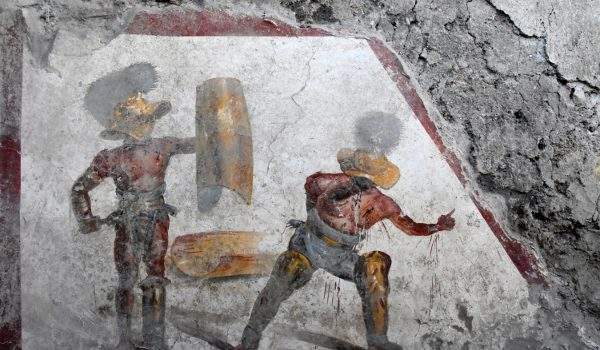The excavations in Pompeii continue to hold surprises. In Regius V, a fresco depicting a fight between two gladiators, a Thracian and a myrmillon , has in fact been discovered. The myrmillon is the one on the left and belongs to the category of scutati, or gladiators equipped with a shield(scutum in Latin), and he is attacking his rival with his gladius in his fist. On his head he wears a broad-brimmed helmet equipped with a visor with plumes and a crest. The other, the Thracian, belongs to the category of parmularii (gladiators equipped with a small circular shield called a parma).
The fresco was found during some security work, is of considerable size as it measures about 1.12 meters by 1.5 meters, and is located in a room behind the intersection widening between Vicolo dei Balconi and Vicolo delle Nozze d’argento. The laceration has a trapeizodaile form, and was located in the undercroft, perhaps of a workshop. Above the painting the imprint of the wooden staircase can be glimpsed. It is likely that the fresco decorated a room frequented by gladiators, perhaps a dive bar with an upper floor, intended for accommodation of the owners of the business or as frequently, especially given the presence of gladiators, for prostitutes.
“It is very likely that this place was frequented by gladiators,” declares Director General Massimo Osanna. “We are in Regio V, not far from the gladiator barracks from where, by the way, the highest number of graffiti inscriptions referring to this world come from. In this fresco, of particular interest is the extremely realistic depiction of wounds, such as the one to the wrist and chest of the succumbing gladiator, which lets the blood spill out and wets the leggings. We do not know what the final outcome of this fight was. One could have died or had a pardon. In this case there is a singular gesture that the wounded Thracian makes with his hand, perhaps, to plead for salvation; it is the gesture of ad locutia, customarily made by the emperor or general to grant a pardon. The environment of discovery is only partially brought to light, on one side emerges another small portion of fresco that reveals the presence of another figure, as the excavation of the same was possible as a result of the remodeling of the slopes of the fronts and their securing, which is the priority need of the entire Regio V site.”
“The archaeological site of Pompeii, until a few years ago,” comments Minister of Cultural Heritage Dario Franceschini, “was known around the world for its negative image: the collapses, the strikes and the lines of tourists under the sun. Today it is a story of redemption and millions more tourists. Today it is a welcoming site, but more importantly it is a place where research has returned, through new excavations. The discovery of this fresco shows that indeed Pompeii is an inexhaustible mine of research and knowledge for the archaeologists of today and the future.”
 |
| Pompeii, large fresco with two gladiators discovered |
Warning: the translation into English of the original Italian article was created using automatic tools. We undertake to review all articles, but we do not guarantee the total absence of inaccuracies in the translation due to the program. You can find the original by clicking on the ITA button. If you find any mistake,please contact us.